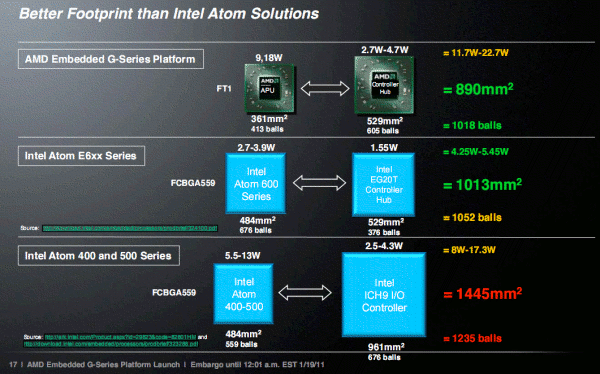Yesterday, AMD announced the first APU (Accelerated Processor Unit) specifically aimed at embedded systems:
AMD (NYSE: AMD) today announced immediate availability of the new AMD Embedded G-Series processor, the world’s first and only Accelerated Processing Unit (APU) for embedded systems. The AMD Embedded G-Series, based on AMD Fusion technology, delivers a complete, full-featured embedded platform and incorporates the new low-power, x86 CPU based on the “Bobcat” core with a world-class DirectX® 11-capable GPU and parallel processing engine on a single piece of silicon.
- This new class of accelerated processor combines more compute capabilities on a single die than any processor in the history of computing and represents opportunity for major advancements in embedded systems.
- No solution with this level of advanced computing is available for the embedded market today.
- Numerous embedded systems based on the AMD Embedded G-Series are available today or expected to launch in the coming weeks from companies including Advansus, Compulab, Congatec, Fujitsu, Haier, iEi, Kontron, Mitec, Quixant, Sintrones, Starnet, WebDT, Wyse, and many others.
- Expected products include graphics-intensive solutions like digital signage, internet-ready set top boxes, mobile and desktop thin clients, casino gaming machines, point-of-sale kiosks, and small form factor PCs, as well as numerous single board computers (SBCs).
- Shane Rau, research director of Computing and Storage Semiconductors at IDC, expects shipments of processors for embedded systems to increase at a double digit rate each year for the next five years.
- This brand new platform continues AMD’s mission to lower power, shrink physical component area, and reduce the costs of designing and producing x86 embedded systems.
Here are AMD Embedded G-Series APU Specifications
- 1 or 2 x86 “Bobcat” CPU cores with 1MB L2 cache, 64-bit Floating Point Unit
- Up to 1.6GHz
- 9W and 18W TDP
- Array of SIMD Engines
- DirectX® 11 capable graphics
- Industry-leading 3D and graphics processing
- 3rd Generation Unified Video Decoder
- Power management features, including C6 and power gating
- DDR3 800-1066 memory with support for 64 bit channel and 2 DIMMs
- Ball Grid Array (BGA) package
- 890mm² physical footprint, including the AMD Fusion I/O Controller Hub

They have 5 single core and dual core models:
- T56N – Dual core @ 1.6GHz with Radeon HD 6310 GPU
- T48N – Dual core @ 1.4 GHz with Radeon HD 6310 GPU
- T40N – Dual core @ 1.0 GHz with Radeon HD 6250 GPU
- T52R – Single core @ 1.5 GHz with Radeon HD 6310 GPU
- T44R – Single core @ 1.2 GHz with Radeon HD 6250 GPU
For further details, please check out AMD Fusion G-Series Product Brief.
AMD G-Series power consumption is relatively high, even compared to Intel Atom (See below), so it won’t be used in portable devices. AMD G-Series processors can already be found in Microsoft Surface 2.0 and a few digital signage players (e.g. MediaVue) and thin clients (e.g. Wyse).

The slide above is extracted from AMD G-Series presentation and shows the advantage of AMD G-series over Intel Atom in terms of footprint and similar power characteristics compared to Intel Atom 400 and 500 Series.

Jean-Luc started CNX Software in 2010 as a part-time endeavor, before quitting his job as a software engineering manager, and starting to write daily news, and reviews full time later in 2011.
Support CNX Software! Donate via cryptocurrencies, become a Patron on Patreon, or purchase goods on Amazon or Aliexpress




